-
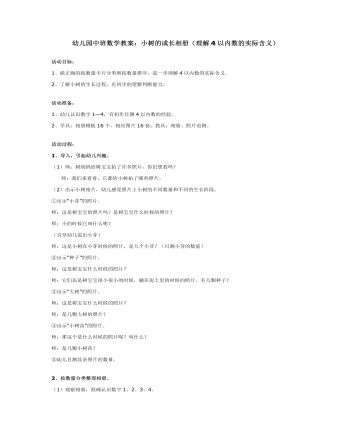
幼儿园中班数学教案:小树的成长相册
2、了解小树的生长过程,有初步的逻辑判断能力。 活动准备: 1、幼儿认识数字1—4,有初步目测4以内数的经验。 2、学具:相册模板16个,相应图片16套;教具:相册、照片范例。 活动过程: 1、导入,引起幼儿兴趣。 (1)师:树妈妈给树宝宝拍了许多照片,你们想看吗? 师:我们来看看,它都给小树拍了哪些照片。 (2)出示小树相片,幼儿感受照片上小树的不同数量和不同的生长阶段。 ①出示“小芽”的照片。 师:这是树宝宝的照片吗?是树宝宝什么时候的照片? 师:小的时候它叫什么呢? (引导幼儿说出小芽) 师:这是小树在小芽时候的照片,是几个小芽?(目测小芽的数量)
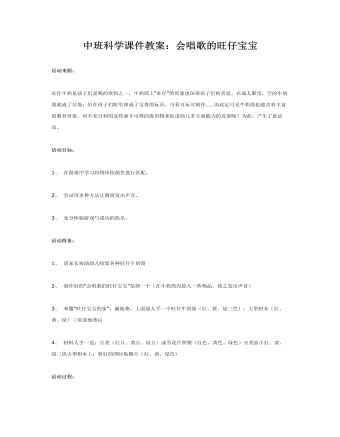
中班科学课件教案:会唱歌的旺仔宝宝
活动目标:1、 在游戏中学习将物体按颜色进行匹配。2、 尝试用多种方法让圆筒发出声音。3、 充分体验游戏与成功的快乐。活动准备:1、 请家长协助幼儿收集各种旺仔牛奶筒2、 制作好的“会唱歌的旺仔宝宝”范例一个(在牛奶筒内放入一些物品,使之发出声音)3、 布置“旺仔宝宝的家”:铺地垫,上面放人手一个旺仔牛奶筒(红、黄、绿三色);大型积木(红、黄、绿)三块放地垫后4、 材料人手一盒:豆类(红豆、黄豆、绿豆)或雪花片积塑(红色、黄色、绿色)分类放于红、黄、绿三块大型积木上;剪好的即时贴圆片(红、黄、绿色)
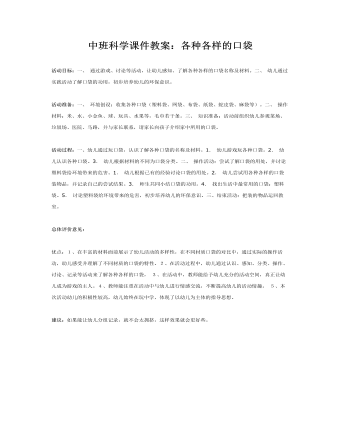
中班科学课件教案:各种各样的口袋
活动准备:一、环境创设:收集各种口袋(塑料袋、网袋、布袋、纸袋、蛇皮袋、麻袋等)。二、操作材料:米、水、小金鱼、球、玩具、水果等,毛巾若干条。三、知识准备:活动前组织幼儿参观菜场、垃圾场、医院、马路,并与家长联系,请家长向孩子介绍家中所用的口袋。 活动过程:一、幼儿通过玩口袋,认识了解各种口袋的名称及材料。1.幼儿游戏玩各种口袋。2.幼儿认识各种口袋。3.幼儿根据材料的不同为口袋分类。二、操作活动:尝试了解口袋的用处,并讨论塑料袋给环境带来的危害。1.幼儿根据已有的经验讨论口袋的用处。2.幼儿尝试用各种各样的口袋装物品,并记录自己的尝试结果。3.师生共同小结口袋的功用。4.找出生活中最常用的口袋:塑料袋。5.讨论塑料袋给环境带来的危害,初步培养幼儿的环保意识。三、结束活动:把装的物品运回教室。
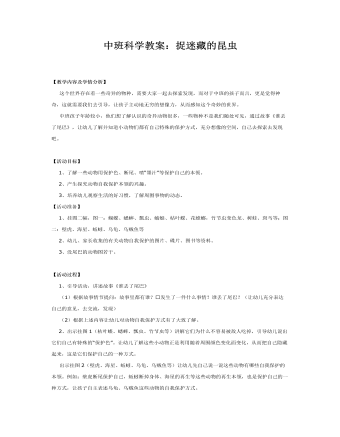
中班科学课件教案:爱捉迷藏的昆虫
【活动目标】 1、了解一些动物用保护色、断尾、喷“墨汁”等保护自己的本领。 2、产生探究动物自我保护本领的兴趣。 3、培养幼儿观察生活的好习惯,了解周围事物的动态。【活动准备】 1、挂图二幅,图一:蝴蝶、蟋蟀、瓢虫、蜻蜓、枯叶蝶、花螳螂,竹节虫变色龙、树蛙、斑马等;图二:壁虎、海星、蚯蚓、乌龟、乌贼鱼等 2、幼儿、家长收集的有关动物自我保护的图片、碟片、图书等资料。 3、没尾巴的动物图若干。 【活动过程】 1、引导活动,讲述故事《谁丢了尾巴》 (1)根据故事情节提问:故事里都有谁?发生了一件什么事情?谁丢了尾巴?(让幼儿充分表达自己的意见,去交流,发现) (2)根据上述内容让幼儿对动物自我保护方式有了大致了解。
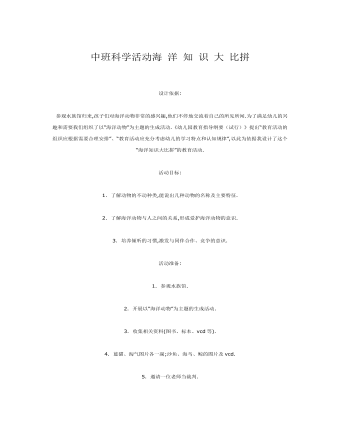
中班科学课件教案:海洋知识大比拼
活动目标:1. 了解动物的不动种类,能说出几种动物的名称及主要特征.2. 了解海洋动物与人之间的关系,形成爱护海洋动物的意识.3. 培养倾听的习惯,激发与同伴合作、竞争的意识.活动准备:1. 参观水族馆.2. 开展以“海洋动物”为主题的生成活动.
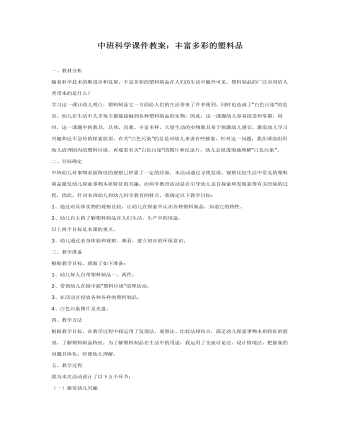
中班科学课件教案:丰富多彩的塑料品
学习这一课让幼儿明白,塑料制品它一方面给人们的生活带来了许多便利,同时也造成了“白色污染”的危害。幼儿在生活中几乎每天都能接触到各种塑料制品的实物,因此,这一课题幼儿容易接受和掌握,同时,这一课题中的教具,具体、直观、丰富多样,大量生动的实物教具易于刺激幼儿感官,激发幼儿学习兴趣和近不急待的探索欲望。有关“白色污染”的总是对幼儿来说有些抽象,针对这一问题,我在课前组织幼儿清理园内的塑料垃圾,再观看有关“白色污染”的图片和纪录片,幼儿会很透彻地理解“白色污染”。 二、目标确定 中班幼儿对事物表面特征的观察已积累了一定的经验,本活动通过寻找发现、观察比较生活中常见的塑料制品激发幼儿探索事物本质特征的兴趣,而科学教育活动是在引导幼儿亲自探索和发展获得有关经验的过程,因此,针对本班幼儿和幼儿科学教育的特点,我确定以下教学目标: 1、通过对具体实物的观察比较,让幼儿在探索中认识各种塑料制品,知道它的特性。 2、幼儿自主的了解塑料制品在人们生活、生产中的用途。 以上两个目标是本课的重点。 3、幼儿通过亲身体验和观察、观看,建立初步的环保意识。

中班科学课件教案:请你猜猜我是谁?
【活动目标】 1、感知人的声音及自然界中各种声音的变化。 2、运用多种方法让幼儿自己的声音发生变化。【活动准备】 1、各种声音的录音(如,下小雨声、尖细的说话声、很慢的高跟鞋走路声;下大雨声、粗重的说话声、很快的高跟鞋走路声;婴儿的哭声、幼儿的说话声、成年的说话声、老年人的说话声)。 2、眼罩一个、录音机一台。【活动过程】 一、倾听两组不同的声音,并进行比较。 1、请幼儿倾听第一段录音:下小雨声、尖细的说话声、很慢的高跟鞋走路声。提问:你听到了什么声音? 2、请幼儿倾听第二段录音:下大雨声,粗重的说话声、很快的高跟鞋走路声。提问:你听到了声音有什么变化吗?
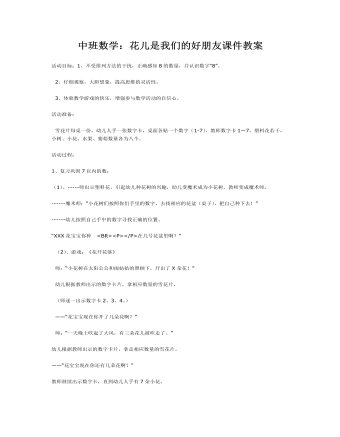
中班数学:花儿是我们的好朋友课件教案
2、仔细观察,大胆想象,提高思维的灵活性。 3、体验数学游戏的快乐,增强参与数学活动的自信心。活动准备: 雪花片每桌一份,幼儿人手一张数字卡,桌面各贴一个数字(1-7),教师数字卡1—7,塑料花若干,小树、小花、水梨、葡萄数量各为八个。活动过程:1、复习巩固7以内的数:(1)、-----师出示塑料花,引起幼儿种花树的兴趣,幼儿变魔术成为小花树,教师变成魔术师。------魔术师:“小花树们按照你们手里的数字,去找相应的花盆(桌子),把自己种下去!”------幼儿按照自己手中的数字寻找正确的位置。“XXX花宝宝你种 在几号花盆里啊?” (2)、游戏:《花开花落》 师:“小花树在太阳公公和雨姑姑的照顾下,开出了X朵花!” 幼儿根据教师出示的数字卡片,拿相应数量的雪花片。 (师逐一出示数字卡2、3、4。)
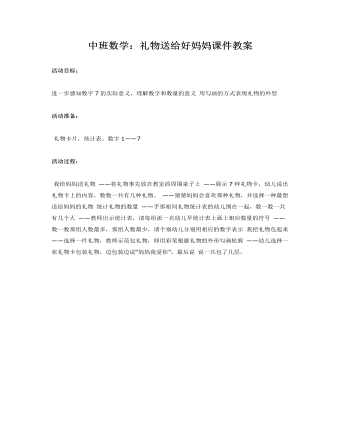
中班数学:礼物送给好妈妈课件教案
活动准备: 礼物卡片,统计表。数字1——7 活动过程: 我给妈妈送礼物 ——将礼物事先放在教室的周围桌子上 ——展示7种礼物卡,幼儿说出礼物卡上的内容,数数一共有几种礼物。 ——猜猜妈妈会喜欢那种礼物,并选择一种最想送给妈妈的礼物统计礼物的数量 ——手那相同礼物统计表的幼儿围在一起,数一数一共有几个人 ——教师出示统计表,请每组派一名幼儿早统计表上画上相应数量的符号 ——数一数那组人数最多,那组人数最少,
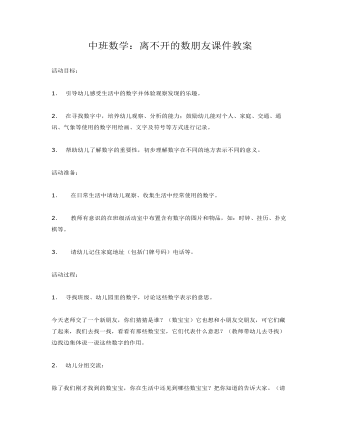
中班数学:离不开的数朋友课件教案
2. 在寻找数字中,培养幼儿观察、分析的能力;鼓励幼儿能对个人、家庭、交通、通讯、气象等使用的数字用绘画、文字及符号等方式进行记录。3. 帮助幼儿了解数字的重要性,初步理解数字在不同的地方表示不同的意义。活动准备:1. 在日常生活中请幼儿观察、收集生活中经常使用的数字。2. 教师有意识的在班级活动室中布置含有数字的图片和物品,如:时钟、挂历、扑克棋等。3. 请幼儿记住家庭地址(包括门牌号码)电话等。
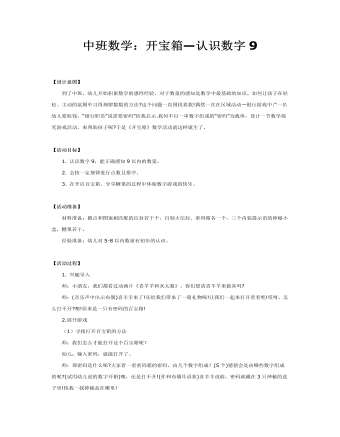
中班数学:开宝箱—认识数字9课件教案
【活动目标】1. 认识数字9,能正确感知9以内的数量。2. 会按一定规律进行点数且排序。3. 在开启百宝箱、分享糖果的过程中体验数字游戏的快乐。 【活动准备】 材料准备:圆点和图案相匹配的信封若干个,自制大信封、密码箱各一个,三个内装提示语的神秘小盒,糖果若干。 经验准备:幼儿对5-8以内数量有初步的认识。 【活动过程】1. 兴趣导入 师:小朋友,我们都看过动画片《喜羊羊和灰太狼》。你们想请喜羊羊来做客吗? 师:(音乐声中出示布偶)喜羊羊来了!还给我们带来了一箱礼物呢!让我们一起来打开看看吧!哎呀,怎么打不开?噢!原来是一只有密码的百宝箱!2.展开游戏 (1)寻找打开百宝箱的方法 师:我们怎么才能打开这个百宝箱呢? 幼儿:输入密码,就能打开了。 师:那密码是什么呢?大家看一看密码箱的密码,由几个数字组成?(5个)猜猜会是由哪些数字组成的呢?(试用幼儿说的数字开箱)噢,还是打不开!(作和布偶耳语状)喜羊羊说啦,密码就藏在3只神秘的盒子里!快找一找神秘盒在哪里!
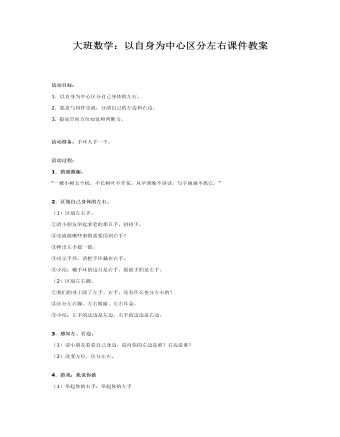
大班数学:以自身为中心区分左右课件教案
2.愿意与同伴交流,分清自己的左边和右边。 3. 提高空间方位知觉和判断力。 活动准备:手环人手一个。活动过程: 1.猜谜激趣。 “一棵小树五个杈,不长树叶不开花。从早到晚不讲话,写字画画不离它。”2.区别自己身体的左右。 (1)区别左右手。 ①请小朋友举起拿笔的那只手,招招手。 ②交流做哪些事情需要用到右手? ③伸出左手摇一摇。 ④出示手环,请把手环戴在右手。 ⑤小结:戴手环的这只是右手。摇摇手的是左手。
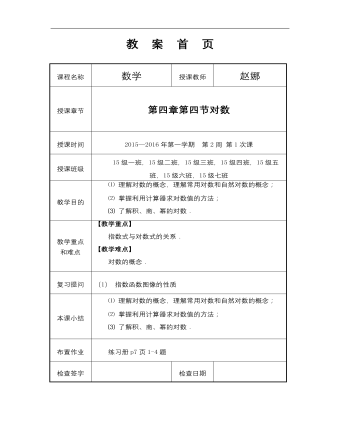
【高教版】中职数学基础模块上册:4.3《对数》优秀教案
课程名称数学授课教师赵娜授课章节第四章第四节对数授课时间2015—2016年第一学期 第2周第1次课授课班级15级一班,15级二班,15级三班,15级四班,15级五班,15级六班,15级七班教学目的⑴ 理解对数的概念,理解常用对数和自然对数的概念; ⑵ 掌握利用计算器求对数值的方法; ⑶了解积、商、幂的对数.教学重点 和难点【教学重点】 指数式与对数式的关系. 【教学难点】 对数的概念.复习提问(1) 指数函数图像的性质本课小结⑴ 理解对数的概念,理解常用对数和自然对数的概念; ⑵ 掌握利用计算器求对数值的方法; ⑶了解积、商、幂的对数.布置作业练习册p7页1-4题检查签字 检查日期

【高教版】中职数学基础模块上册:2.2《区间》教案设计
教师姓名 课程名称数学班 级 授课日期 授课顺序 章节名称§2.2 区间教 学 目 标知识目标:1、理解区间的概念 2、掌握区间的表示方法 技能目标:1、能进行区间与不等式的互相转换 2、能在数轴上正确画出相应的区间 情感目标:体会不等式在日常生活中的应用,感受数学的有用性教学 重点 和 难点 重点: 不等式的概念和基本性质 难点: 1、会比较两个整式的大小 2、能根据应用题的表述,列出相应的表达式教 学 资 源《数学》(第一册) 多媒体课件评 估 反 馈课堂提问 课堂练习作 业习题2.1
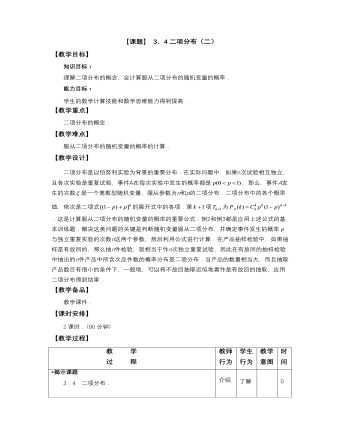
【高教版】中职数学拓展模块:3.4《二项分布》教案设计
教 学 过 程教师 行为学生 行为教学 意图时间 *揭示课题 3.4 二项分布. *创设情境 兴趣导入 我们来看一个问题:从100件产品中有3件不合格品,每次抽取一件有放回地抽取三次,抽到不合格品的次数用表示,求离散型随机变量的概率分布. 由于是有放回的抽取,所以这种抽取是是独立的重复试验.随机变量的所有取值为:0,1,2,3.显然,对于一次抽取,抽到不合格品的概率为0.03,抽到合格品的概率为1-0.03.于是的概率(仅求到组合数形式)分别为: , , , . 所以,随机变量的概率分布为 0123P 介绍 播放 课件 质疑 了解 观看 课件 思考 引导 启发学生得出结果 0 10*动脑思考 探索新知 一般地,如果在一次试验中某事件A发生的概率是P,随机变量为n次独立试验中事件A发生的次数,那么随机变量的概率分布为: 01…k…nP…… 其中. 我们将这种形式的随机变量的概率分布叫做二项分布.称随机变量服从参数为n和P的二项分布,记为~B(n,P). 二项分布中的各个概率值,依次是二项式的展开式中的各项.第k+1项为. 二项分布是以伯努利概型为背景的重要分布,有着广泛的应用. 在实际问题中,如果n次试验相互独立,且各次实验是重复试验,事件A在每次实验中发生的概率都是p(0<p<1),则事件A发生的次数是一个离散型随机变量,服从参数为n和P的二项分布. 总结 归纳 分析 关键 词语 思考 理解 记忆 引导学生发现解决问题方法 20

新人教版高中英语选修2Unit 2 Reading and thinking教学设计
Her tutor told her to acknowledge __________ other people had said if she cited their ideas, and advised her _______(read) lots of information in order to form __________wise opinion of her own.Now halfway __________ her exchange year, Xie Lei felt much more at home in the UK. She said __________ (engage) in British culture had helped and that she had been__________ (involve) in social activities. She also said while learning about business, she was acting as a cultural messenger __________(build) a bridge between the two countries. keys:Xie Lei, a 19yearold Chinese student, said goodbye to her family and friends in China and boarded (board) a plane for London six months ago in order to get a business qualification. She was ambitious(ambition) to set up a business after graduation. It was the first time that she had left (leave) home.At first, Xie Lei had to adapt to life in a different country. She chose to live with a host family, who can help with her adaptation (adapt) to the new culture. When she missed home, she felt comforted (comfort) to have a second family. Also Xie Lei had to satisfy academic requirements. Her tutor told her to acknowledge what other people had said if she cited their ideas, and advised her to read lots of information in order to form a wise opinion of her own.Now halfway through her exchange year, Xie Lei felt much more at home in the UK. She said engaging (engage) in British culture had helped and that she had been involved (involve) in social activities. She also said while learning about business, she was acting as a cultural messenger building a bridge between the two countries.

新人教版高中英语选修2Unit 2 Using langauge-Listening教学设计
? B: Absolutely! Getting involved with Chinese cultural activities there definitely helped a lot. I got to practice my Chinese on a daily basis, and I could learn how native Chinese speakers spoke.? A: What do you feel is your biggest achievement?? B: Learning Chinese characters! I have learnt about 1,500 so far. When I first started, I didn't think it was even going to be possible to learn so many, but now I find that I can read signs, menus, and even some easy newspaper articles.? A: What are you most keen on?? B: I've really become keen on learning more about the Chinese culture, in particular Chinese calligraphy. As I have learnt Chinese characters, I have developed a great appreciation for their meaning. I want to explore Chinese characters by learning how to write them in a more beautiful way. ? A: Finally, what do you want to say to anyone interested in learning Chinese?? I have really become keen on learning more about the Chinese culture, in particular Chinese Calligraphy. As I have learnt Chinese character, I have developed a great appreciation for their meaning. I want to explore Chinese characters by learning how to write them in a more beautiful way.? A: Finally, what do you want to say to anyone interested in learning Chinese?? B: I'd say, give it a shot! While some aspects may be difficult, it is quite rewarding and you will be happy that you tried.? A: Thanks for your time. ? B:You're welcome.

新人教版高中英语选修2Unit 3 Using langauge-Listening教学设计
1. How is Hunan cuisine somewhat different from Sichuan cuisine?The heat in Sichuan cuisine comes from chilies and Sichuan peppercorns. Human cuisine is often hotter and the heat comes from just chilies.2.What are the reasons why Hunan people like spicy food?Because they are a bold people. But many Chinese people think that hot food helps them overcome the effects of rainy or wet weather.3.Why do so many people love steamed fish head covered with chilies?People love it because the meat is quite tender and there are very few small bones.4.Why does Tingting recommend bridge tofu instead of dry pot duck with golden buns?Because bridge tofu has a lighter taste.5 .Why is red braised pork the most famous dish?Because Chairman Mao was from Hunan, and this was his favorite food.Step 5: Instruct students to make a short presentation to the class about your choice. Use the example and useful phrases below to help them.? In groups of three, discuss what types of restaurant you would like to take a foreign visitor to, and why. Then take turns role-playing taking your foreign guest to the restaurant you have chosen. One of you should act as the foreign guest, one as the Chinese host, and one as the waiter or waitress. You may start like this:? EXAMPLE? A: I really love spicy food, so what dish would you recommend?? B: I suggest Mapo tofu.? A: Really ? what's that?

新人教版高中英语选修2Unit 4 Using langauge-Listening教学设计
The theme of the listening section is " talking about scenery and culture along a journey."The part is designed to further lead the students to understand Canadian natural geography and social environment, and integrated into the cultural contrast by mentioning the long train journey from Beijing to Moscow routes. On this basis, the part activates students related travel experience, lets the student serial dialogue, guides the student to explore further the pleasure and meaning of the long journey, and Chinese and foreign cultural comparison.The part also provides a framework for the continuation of the dialogue, which is designed to provide a framework for students to successfully complete their oral expressions, and to incorporate an important trading strategy to end the dialogue naturally.1. Help students to understand and master some common English idioms in the context, and experience the expression effect of English idioms.2. Guide the students to understand the identity of different people in the listening context, and finish the dialogue according to their own experience.3. Instruct the students to use appropriate language to express surprise and curiosity about space and place in the dialogue, and master the oral strategy of ending the dialogue naturally.1. Instruct students to grasp the key information and important details of the dialogue.2. Instruct students to conduct a similar talk on the relevant topic.

新人教版高中英语选修2Unit 5 Reading and thinking教学设计
The theme of this activity is to learn the first aid knowledge of burns. Burns is common in life, but there are some misunderstandings in manual treatment. This activity provides students with correct first aid methods, so as not to take them for granted in an emergency. This section guides students to analyze the causes of scald and help students avoid such things. From the perspective of text structure and collaborative features, the text is expository. Expository, with explanation as the main way of expression, transmits knowledge and information to readers by analyzing concepts and elaborating examples. This text arranges the information in logical order, clearly presents three parts of the content through the subtitle, accurately describes the causes, types, characteristics and first aid measures of burns, and some paragraphs use topic sentences to summarize the main idea, and the level is very clear.1. Guide students to understand the causes, types, characteristics and first aid methods of burns, through reading2. Enhance students’ ability to deal withburnss and their awareness of burns prevention3. Enable students to improve the ability to judge the types of texts accurately and to master the characteristics and writing techniques of expository texts.Guide students to understand the causes, types, characteristics and first aid methods of burns, through readingStep1: Lead in by discussing the related topic:1. What first-aid techniques do you know of ?CPR; mouth to mouth artificial respiration; the Heimlich Manoeuvre

